CHEVROLET Avalanche 2010 User Manual

2012 Chevrolet Avalanche Owner Manual M
In Brief . . . . . . . . . . . . . . . . . . . . . . . . 1-1
Instrument Panel . . . . . . . . . . . . . . 1-2
Initial Drive Information . . . . . . . . 1-4
Vehicle Features . . . . . . . . . . . . . 1-19
Performance and
Maintenance . . . . . . . . . . . . . . . . 1-25
Keys, Doors, and
Windows . . . . . . . . . . . . . . . . . . . . 2-1
Keys and Locks . . . . . . . . . . . . . . . 2-2
Doors . . . . . . . . . . . . . . . . . . . . . . . . . . 2-9
Vehicle Security. . . . . . . . . . . . . . 2-17
Exterior Mirrors . . . . . . . . . . . . . . . 2-20
Interior Mirrors . . . . . . . . . . . . . . . . 2-22
Windows . . . . . . . . . . . . . . . . . . . . . 2-23
Roof . . . . . . . . . . . . . . . . . . . . . . . . . . 2-25
Seats and Restraints . . . . . . . . . 3-1
Head Restraints . . . . . . . . . . . . . . . 3-2
Front Seats . . . . . . . . . . . . . . . . . . . . 3-3
Rear Seats . . . . . . . . . . . . . . . . . . . 3-10
Safety Belts . . . . . . . . . . . . . . . . . . 3-12
Airbag System . . . . . . . . . . . . . . . . 3-22
Child Restraints . . . . . . . . . . . . . . 3-36
Storage . . . . . . . . . . . . . . . . . . . . . . . 4-1
Storage Compartments . . . . . . . . 4-1
Luggage/Load Locations . . . . . . . 4-2
Additional Storage Features . . . 4-6
Roof Rack System . . . . . . . . . . . 4-13
Instruments and Controls . . . . 5-1
Controls . . . . . . . . . . . . . . . . . . . . . . . 5-2
Warning Lights, Gauges, and
Indicators . . . . . . . . . . . . . . . . . . . 5-10
Information Displays . . . . . . . . . . 5-26
Vehicle Messages . . . . . . . . . . . . 5-35
Vehicle Personalization . . . . . . . 5-45
Universal Remote System . . . . 5-53
Lighting . . . . . . . . . . . . . . . . . . . . . . . 6-1
Exterior Lighting . . . . . . . . . . . . . . . 6-1
Interior Lighting . . . . . . . . . . . . . . . . 6-7
Lighting Features . . . . . . . . . . . . . . 6-8
Infotainment System . . . . . . . . . 7-1
Introduction . . . . . . . . . . . . . . . . . . . . 7-1
Radio . . . . . . . . . . . . . . . . . . . . . . . . . . 7-8
Audio Players . . . . . . . . . . . . . . . . 7-14
Rear Seat Infotainment . . . . . . . 7-35
Phone . . . . . . . . . . . . . . . . . . . . . . . . 7-47
Trademarks and License
Agreements . . . . . . . . . . . . . . . . . 7-54
Climate Controls . . . . . . . . . . . . . 8-1
Climate Control Systems . . . . . . 8-1
Air Vents . . . . . . . . . . . . . . . . . . . . . 8-10
Driving and Operating . . . . . . . . 9-1
Driving Information . . . . . . . . . . . . . 9-2
Starting and Operating . . . . . . . 9-22
Engine Exhaust . . . . . . . . . . . . . . 9-31
Automatic Transmission . . . . . . 9-32
Drive Systems . . . . . . . . . . . . . . . . 9-37
Brakes . . . . . . . . . . . . . . . . . . . . . . . 9-44
Ride Control Systems . . . . . . . . 9-46
Cruise Control . . . . . . . . . . . . . . . . 9-51
Object Detection Systems . . . . 9-54
Fuel . . . . . . . . . . . . . . . . . . . . . . . . . . 9-60
Towing . . . . . . . . . . . . . . . . . . . . . . . 9-66
Conversions and Add-Ons . . . 9-84

2012 Chevrolet Avalanche Owner Manual M
Vehicle Care . . . . . . . . . . . . . . . . . 10-1
General Information . . . . . . . . . . 10-2
Vehicle Checks . . . . . . . . . . . . . . . 10-4
Headlamp Aiming . . . . . . . . . . . 10-35
Bulb Replacement . . . . . . . . . . 10-38
Electrical System . . . . . . . . . . . . 10-40
Wheels and Tires . . . . . . . . . . . 10-49
Jump Starting . . . . . . . . . . . . . . . 10-86
Towing . . . . . . . . . . . . . . . . . . . . . . 10-91
Appearance Care . . . . . . . . . . . 10-96
Service and Maintenance . . . 11-1
General Information . . . . . . . . . . 11-1
Maintenance Schedule . . . . . . . 11-3
Special Application
Services . . . . . . . . . . . . . . . . . . . . 11-8
Additional Maintenance
and Care . . . . . . . . . . . . . . . . . . . . 11-9
Recommended Fluids,
Lubricants, and Parts . . . . . . 11-12
Maintenance Records . . . . . . . 11-15
Technical Data . . . . . . . . . . . . . . . 12-1
Vehicle Identification . . . . . . . . . 12-1
Vehicle Data . . . . . . . . . . . . . . . . . . 12-2
Customer Information . . . . . . . 13-1
Customer Information . . . . . . . . 13-1
Reporting Safety Defects . . . . 13-17
Vehicle Data Recording and
Privacy. . . . . . . . . . . . . . . . . . . . 13-19
OnStar . . . . . . . . . . . . . . . . . . . . . . . 14-1
OnStar Overview. . . . . . . . . . . . . 14-1
OnStar Services . . . . . . . . . . . . . . 14-2
OnStar Additional
Information . . . . . . . . . . . . . . . . . . 14-5
Index . . . . . . . . . . . . . . . . . . . . . i-1

Introduction iii
The names, logos, emblems, slogans, vehicle model names, and vehicle body designs appearing in this manual including, but not limited to, GM, the GM logo, CHEVROLET, the CHEVROLET Emblem, AVALANCHE, and Z71 are trademarks and/or service marks
of General Motors LLC, its subsidiaries, affiliates, or licensors.
This manual describes features that may or may not be on your specific vehicle either because they are options that you did not purchase or due to changes subsequent to the printing of this owner manual.
Please refer to the purchase documentation relating to your specific vehicle to confirm each of the features found on your vehicle. For vehicles first sold in Canada, substitute the name “General Motors of Canada Limited” for Chevrolet Motor Division wherever it appears in this manual.
Keep this manual in the vehicle for quick reference.
Canadian Vehicle Owners
Propriétaires Canadiens
A French language copy of this manual can be obtained from your dealer or from:
On peut obtenir un exemplaire de ce guide en français auprès du concessionnaire ou à l'adresse suivante:
Helm, Incorporated
P.O. Box 07130
Detroit, MI 48207
1-800-551-4123
Numéro de poste 6438 de langue française www.helminc.com
Litho in U.S.A. |
© 2011 General Motors LLC. All Rights Reserved. |
Part No. 20902915 A First Printing |
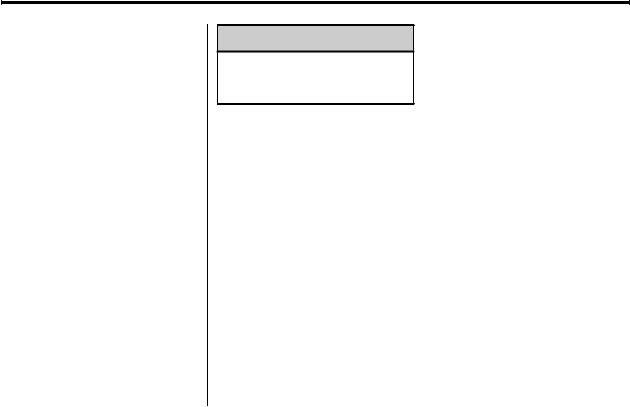
iv Introduction
Using this Manual
To quickly locate information about the vehicle, use the Index in the back of the manual. It is an alphabetical list of what is in the manual and the page number where it can be found.
Danger, Warnings, and
Cautions
Warning messages found on vehicle labels and in this manual describe hazards and what to do to avoid or reduce them.
Danger indicates a hazard with a high level of risk which will result in serious injury or death.
Warning or Caution indicates a hazard that could result in injury or death.
{WARNING
These mean there is something that could hurt you or other people.
Notice: This means there is something that could result in property or vehicle damage. This would not be covered by the vehicle's warranty.
A circle with a slash through it is a safety symbol which means “Do Not,” “Do not do this,” or “Do not let this happen.”
Symbols
The vehicle has components and labels that use symbols instead of text. Symbols are shown along with the text describing the operation or information relating to a specific component, control, message, gauge, or indicator.
M : This symbol is shown when you need to see your owner manual for additional instructions or information.
* : This symbol is shown when you need to see a service manual for additional instructions or information.

Introduction v
Vehicle Symbol Chart
Here are some additional symbols that may be found on the vehicle and what they mean. For more information on the symbol, refer to the Index.
0 : Adjustable Pedals
9 : Airbag Readiness Light
# : Air Conditioning
! : Antilock Brake System (ABS)
% : Audio Steering Wheel Controls or OnStar®
$ : Brake System Warning Light
" : Charging System
I : Cruise Control
B : Engine Coolant Temperature
O : Exterior Lamps
# : Fog Lamps
. : Fuel Gauge
+ : Fuses
3 : Headlamp High/Low-Beam
Changer
( : Heated Steering Wheel
j : LATCH System Child
Restraints
* : Malfunction Indicator Lamp
: : Oil Pressure
g : Outside Power Foldaway
Mirrors
} : Power
/ : Remote Vehicle Start
> : Safety Belt Reminders
7 : Tire Pressure Monitor
_ : Tow/Haul Mode
d : Traction Control/StabiliTrak®
M : Windshield Washer Fluid

vi Introduction
2 NOTES

In Brief |
1-1 |
In Brief
Instrument Panel
Instrument Panel . . . . . . . . . . . . . . 1-2
Initial Drive Information
Initial Drive Information . . . . . . . . 1-4
Remote Keyless Entry (RKE)
System . . . . . . . . . . . . . . . . . . . . . . 1-4
Remote Vehicle Start . . . . . . . . . 1-5
Door Locks . . . . . . . . . . . . . . . . . . . 1-5
Midgate® . . . . . . . . . . . . . . . . . . . . . . 1-6
Tailgate . . . . . . . . . . . . . . . . . . . . . . . 1-6
Windows . . . . . . . . . . . . . . . . . . . . . . 1-6
Seat Adjustment . . . . . . . . . . . . . . 1-7
Memory Features . . . . . . . . . . . . . 1-9
Second Row Seats . . . . . . . . . . 1-10
Heated and Ventilated
Seats . . . . . . . . . . . . . . . . . . . . . . . 1-11
Head Restraint
Adjustment . . . . . . . . . . . . . . . . . 1-11
Safety Belts . . . . . . . . . . . . . . . . . . 1-11
Passenger Sensing
System . . . . . . . . . . . . . . . . . . . . . 1-12
Mirror Adjustment . . . . . . . . . . . . 1-12
Steering Wheel
Adjustment . . . . . . . . . . . . . . . . . 1-13
Throttle and Brake Pedal
Adjustment . . . . . . . . . . . . . . . . . 1-13
Interior Lighting . . . . . . . . . . . . . . 1-14
Exterior Lighting . . . . . . . . . . . . . 1-14
Windshield Wiper/Washer . . . . 1-15
Climate Controls . . . . . . . . . . . . . 1-16
Transmission . . . . . . . . . . . . . . . . 1-17
Four-Wheel Drive . . . . . . . . . . . . 1-18
Vehicle Features
Radio(s) . . . . . . . . . . . . . . . . . . . . . 1-19
Satellite Radio . . . . . . . . . . . . . . . 1-20
Portable Audio Devices . . . . . . 1-21
Bluetooth® . . . . . . . . . . . . . . . . . . . 1-21
Steering Wheel Controls . . . . . 1-21
Cruise Control . . . . . . . . . . . . . . . 1-22
Navigation System . . . . . . . . . . . 1-22
Driver Information
Center (DIC) . . . . . . . . . . . . . . . 1-23
Rear Vision
Camera (RVC) . . . . . . . . . . . . . 1-24
Ultrasonic Parking Assist . . . . 1-24
Power Outlets . . . . . . . . . . . . . . . 1-24
Universal Remote System . . . 1-24
Performance and Maintenance
StabiliTrak® System . . . . . . . . . 1-25 Tire Pressure Monitor . . . . . . . . 1-25 Engine Oil Life System . . . . . . 1-25 Fuel E85 (85% Ethanol) . . . . . 1-26 Driving for Better Fuel
Economy . . . . . . . . . . . . . . . . . . . 1-26 Roadside Assistance
Program . . . . . . . . . . . . . . . . . . . . 1-27 OnStar® . . . . . . . . . . . . . . . . . . . . . 1-27
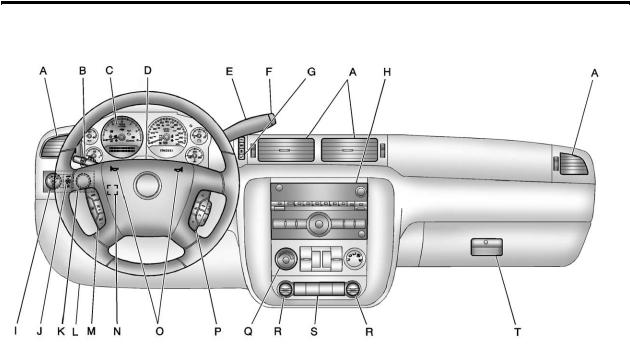
1-2 In Brief
Instrument Panel

In Brief |
1-3 |
A.Air Vents on page 8 10.
B.Turn and Lane Change Lever. See Turn and Lane-Change Signals on page 6 5.
Windshield Wiper/Washer on page 5 5.
C.Instrument Cluster on page 5 11.
D.Hazard Warning Flashers on page 6 5 (Out of View).
E.Shift Lever. See Automatic Transmission on page 9 32.
F.Tow/Haul Mode on page 9 36
(If Equipped).
G.Driver Information Center (DIC) Buttons. See Driver Information Center (DIC) on page 5 26.
H.AM-FM Radio on page 7 8.
I.Exterior Lamp Controls on page 6 1.
J.Dome Lamp Override. See
Dome Lamps on page 6 7.
Instrument Panel Illumination Control on page 6 7.
Fog Lamps on page 6 6
(If Equipped).
K.Automatic Transfer Case Control (If Equipped). See
Four-Wheel Drive (Two Speed Automatic Transfer Case) on page 9 37 or Four-Wheel Drive (Single Speed Automatic Transfer Case) on page 9 42.
L.Data Link Connector (DLC) (Out of View). See Malfunction Indicator Lamp on page 5 19.
M.Cruise Control on page 9 51.
N.Steering Wheel Adjustment on page 5 2.
O.Horn on page 5 5.
P.Steering Wheel Controls on page 5 3.
Q.Climate Control Systems on page 8 1 (If Equipped).
Dual Automatic Climate Control System on page 8 4
(If Equipped).
R.Power Outlets on page 5 9.
S.StabiliTrak® System on page 9 46.
Pedal Adjust Control (If Equipped). See Adjustable Throttle and Brake Pedal on page 9 22.
Ultrasonic Parking Assist on page 9 54 (If Equipped).
Power Assist Steps on page 2 16 (If Equipped).
T.Glove Box on page 4 1.
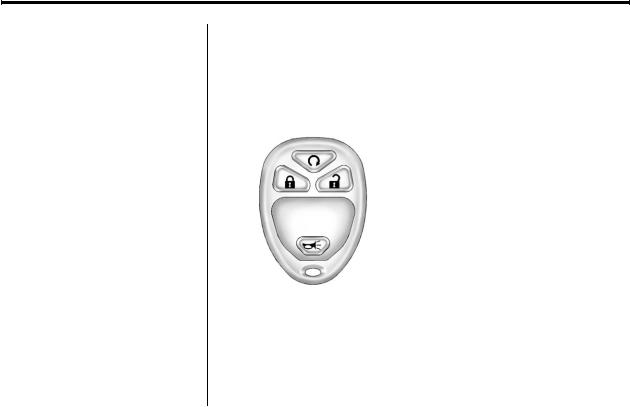
1-4 In Brief
Initial Drive
Information
This section provides a brief overview about some of the important features that may or may not be on your specific vehicle.
For more detailed information, refer to each of the features which can be found later in this owner manual.
Remote Keyless Entry
(RKE) System
The RKE transmitter is used to remotely lock and unlock the doors from up to 60 m (195 ft) away from the vehicle.
K : Press to unlock the driver door. Press K again within three seconds to unlock all remaining doors.
Q : Press to lock all doors. Lock and unlock feedback can be personalized. See Vehicle Personalization (With DIC Buttons) on page 5 45.
L : Press and release to locate the vehicle. Press L and hold for more than two seconds to sound the panic alarm. Press L again to cancel the panic alarm.
See Keys on page 2 2 and Remote Keyless Entry (RKE) System Operation on page 2 3.

In Brief |
1-5 |
Remote Vehicle Start
With this feature the engine can be started from outside of the vehicle.
Starting the Vehicle
1.Aim the RKE transmitter at the vehicle.
2.Press and release Q.
3.Immediately after completing Step 2, press and hold / until the turn signal lamps flash.
When the vehicle starts, the parking lamps will turn on and remain on as long as the engine is running. The doors will be locked and the climate control system may come on.
The engine will continue to run for 10 minutes. Repeat the steps for a 10-minute time extension. Remote start can be extended only once.
Canceling a Remote Start
To cancel a remote start:
.Aim the RKE transmitter at the vehicle and press and hold / until the parking lamps turn off.
.Turn on the hazard warning flashers.
.Turn the ignition on and then back off.
See Remote Vehicle Start on page 2 5.
Door Locks
There are several ways to lock and unlock the vehicle.
From outside, use the Remote Keyless Entry (RKE) transmitter or the key in the driver door.
From inside, use the power door locks or the manual door locks. To lock or unlock the door with the manual locks, push down or pull up on the manual lock knob.
Power Door Locks
If available, the switches are on the front doors.
K : Press to unlock the doors.
Q : Press to lock the doors.
See Door Locks on page 2 7.
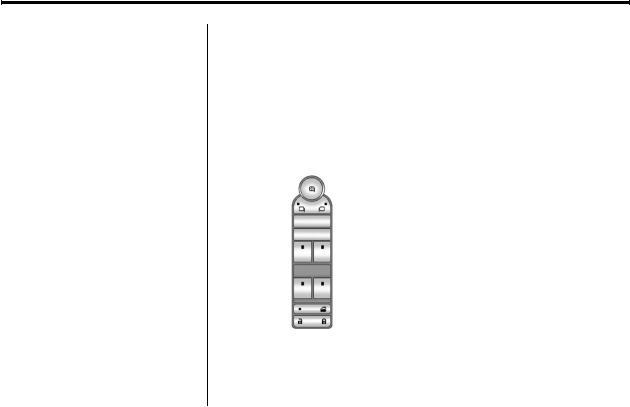
1-6 In Brief
Midgate®
This vehicle is equipped with a Midgate and a removable rear glass panel. The Midgate allows you to extend the length of the vehicle's cargo area.
For more information see Midgate® on page 2 9.
Tailgate
Use the Remote Keyless
Entry (RKE) transmitter or power door lock switch to lock and unlock the tailgate.
Open the tailgate by lifting up on its handle while pulling the tailgate toward you.
To close the tailgate, push it firmly upward until it latches. Push and pull on the tailgate to be sure it is latched securely.
Tailgate Removal
The tailgate is not to be removed. Removing the tailgate may cause damage to the electrical connector resulting in a loss of lock/unlock and rear vision camera function.
See Tailgate on page 2 16.
Windows
The power window controls are located on each of the side doors.
The driver door also has switches that control the front passenger and rear windows. The power windows work when the ignition is in ON/ RUN or ACC/ACCESSORY, or in Retained Accessory Power (RAP). See Retained Accessory Power (RAP) on page 9 28.
Press the switch to lower the window. Pull the switch up to raise it.
For more information, see:
.Windows on page 2 23.
.Power Windows on page 2 24.
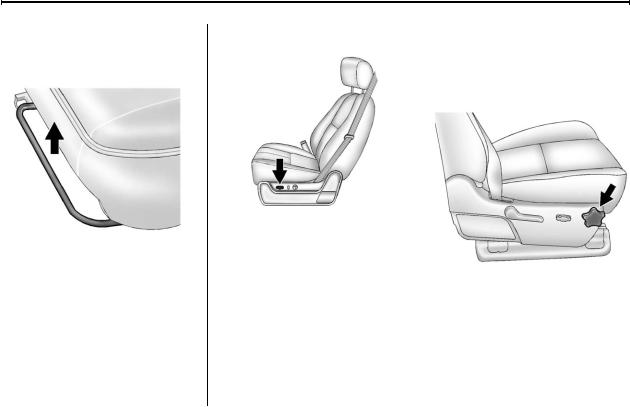
In Brief |
1-7 |
Seat Adjustment
Manual Seats
To adjust the seat:
1.Lift the bar to unlock the seat.
2.Slide the seat to the desired position and release the bar.
3.Try to move the seat back and forth to be sure the seat is locked in place.
See Seat Adjustment on page 3 3 for more information.
Power Seats
To adjust a power seat, if equipped:
.Move the seat forward or rearward by sliding the control forward or rearward.
.If available, raise or lower the front or rear part of the seat cushion by moving the front or rear of the control up or down.
.If available, raise or lower the entire seat by moving the entire control up or down.
See Power Seat Adjustment on page 3 4 for more information.
Lumbar Adjustment
Manual Lumbar
If equipped, increase or decrease manual lumbar support by turning the knob forward or rearward.
See Lumbar Adjustment on page 3 4 for more information.
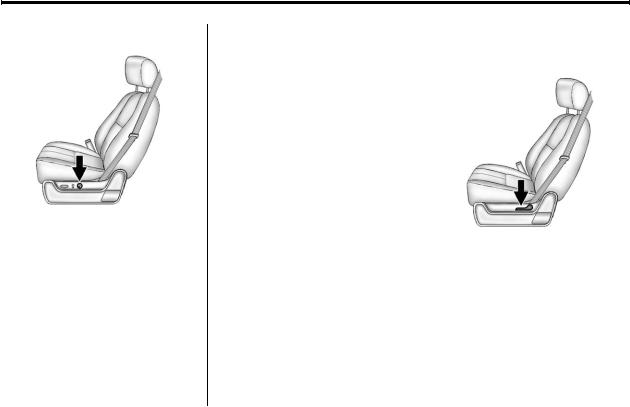
1-8 In Brief
Power Lumbar
To adjust the power lumbar support, if equipped:
.On vehicles with two-way lumbar, press and hold the top or bottom of the control to increase or decrease lumbar support.
.On vehicles with four-way lumbar, press and hold the front or rear of the control to increase or decrease lumbar support. To raise or lower the height of the support, press and hold the top or bottom of the control.
See Lumbar Adjustment on page 3 4 for more information.
Reclining Seatbacks
Manual Reclining Seatbacks
To recline a manual seatback:
1.Lift the lever.
2.Move the seatback to the desired position, and then release the lever to lock the seatback in place.
3.Push and pull on the seatback to make sure it is locked.
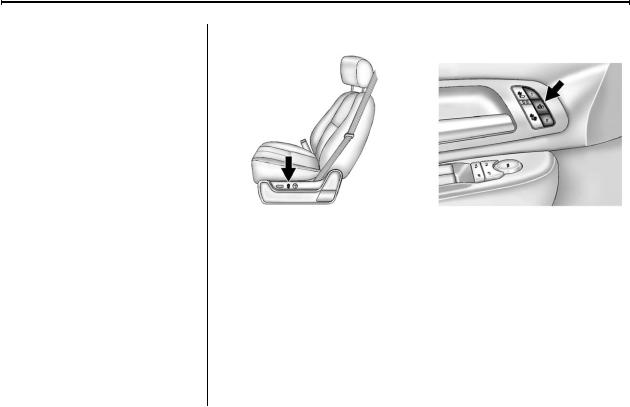
In Brief |
1-9 |
To return the seatback to the upright |
Power Reclining Seatbacks |
position: |
|
1.Lift the lever fully without applying pressure to the seatback, and the seatback will return to the upright position.
2.Push and pull on the seatback to make sure it is locked.
See Reclining Seatbacks on page 3 5 for more information.
To adjust a power seatback, if equipped:
. Tilt the top of the control rearward to recline.
. Tilt the top of the control forward to raise.
See Reclining Seatbacks on page 3 5 for more information.
Memory Features
On vehicles with the memory feature, the controls on the driver door are used to program and recall memory settings for the driver seat, outside mirrors, and the adjustable throttle and brake pedals,
if equipped.

1-10 |
In Brief |
Storing Memory Positions
To save into memory:
1.Adjust the driver seat and seatback recliner, both outside mirrors, and the throttle and brake pedals, if equipped.
See Power Mirrors on page 2 20 and Adjustable Throttle and Brake Pedal on page 9 22 for more information.
Not all mirrors and adjustable throttle and brake pedals will have the ability to save and recall their positions.
2.Press and hold “1” until two beeps sound.
3.Repeat for a second driver position using “2.”
To recall, press and release “1” or “2.” The vehicle must be in P (Park). A single beep will sound. The seat, outside mirrors, and adjustable throttle and brake pedals,
if equipped, will move to the position previously stored for the identified driver.
See Memory Seats on page 3 7 and Vehicle Personalization (With DIC Buttons) on page 5 45 for more information.
Easy Exit Driver Seat
This feature can move the seat rearward to allow extra room to exit the vehicle.
B : Press to recall the easy exit seat position. The vehicle must be in P (Park).
See Memory Seats on page 3 7 and Vehicle Personalization (With DIC Buttons) on page 5 45 for more information.
Second Row Seats
The rear seatbacks can be folded to provide more cargo space and access to the midgate.
For detailed instructions see Rear Seats on page 3 10.
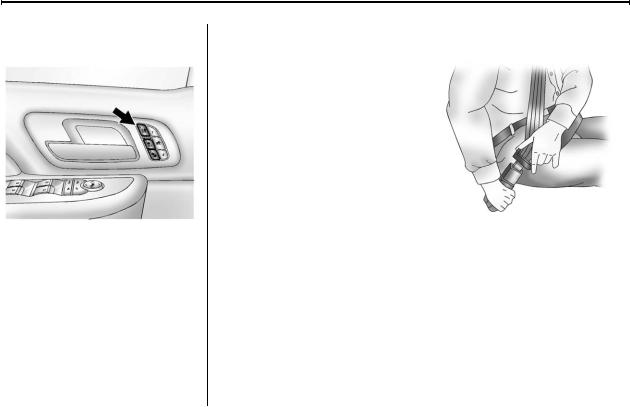
In Brief |
1-11 |
Heated and Ventilated
Seats
Heated and Cooled Seat Buttons
Shown, Heated Seat Buttons
Similar
If available, the buttons are on the front doors.
H : If available, press to cool the seat.
I : Press to heat the seatback only.
J : Press to heat the seat and seatback.
Press the button once for the highest setting. With each press of the button, the seat will change to the next lower setting, and then to the off setting. The lights indicate three for the highest setting and one for the lowest.
See Heated and Ventilated Front Seats on page 3 9.
Head Restraint
Adjustment
Do not drive until the head restraints for all occupants are installed and adjusted properly.
To achieve a comfortable seating position, change the seatback recline angle as little as necessary while keeping the seat and the head restraint height in the proper position.
For more information see Head Restraints on page 3 2 and Seat Adjustment on page 3 3.
Safety Belts
Refer to the following sections for important information on how to use safety belts properly.
.Safety Belts on page 3 12.
.How to Wear Safety Belts Properly on page 3 13.
.Lap-Shoulder Belt on page 3 14.
.Lower Anchors and Tethers for Children (LATCH System) on page 3 45.
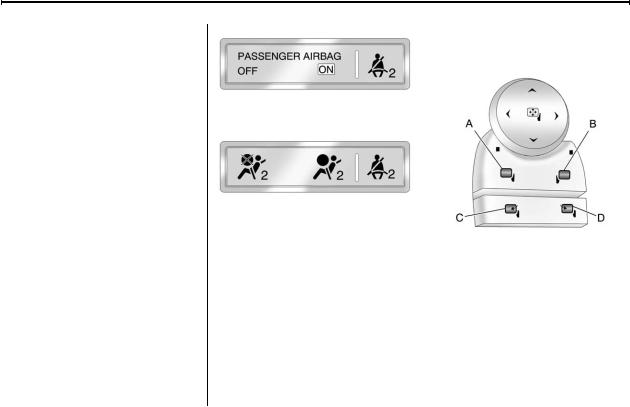
1-12 |
In Brief |
Passenger Sensing
System
The passenger sensing system, if equipped, turns off the front outboard passenger frontal airbag under certain conditions. No other
airbag is affected by the passenger sensing system.
If the vehicle has one of the indicators pictured in the following illustrations, then the vehicle has a passenger sensing system for the right front passenger position.
The passenger airbag status indicator, if equipped, will be visible on the overhead console when the vehicle is started.
United States
Canada and Mexico
See Passenger Sensing System on page 3 29 for important information.
Mirror Adjustment
Exterior Mirrors
Vehicles with outside power mirrors and foldaway mirrors have controls on the driver door.
1.Press (A) or (B) to select the driver or passenger side mirror.
2.Press one of the four arrows located on the control pad to adjust the mirror.
3.Press either (A) or (B) again to deselect the mirror.
See Power Mirrors on page 2 20.
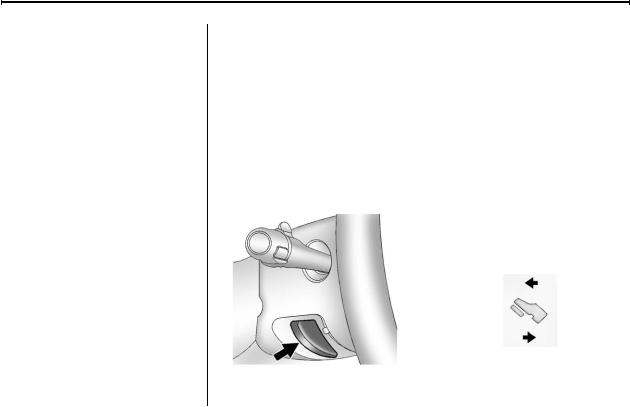
In Brief |
1-13 |
Power Foldaway Mirrors
To fold the mirrors:
1.Press (C) to fold the mirrors out to the driving position.
2.Press (D) to fold the mirrors in to the folded position.
Manual Foldaway Mirrors
Manually fold the mirrors inward to prevent damage when going through an automatic car wash.
To fold, pull the mirror toward the vehicle. Push the mirror outward, to return to its original position.
See Folding Mirrors on page 2 21.
Interior Mirror
Vehicles with a manual rearview mirror can be adjusted to see clearly behind the vehicle. Hold the mirror in the center to move it up or
down and side to side. To reduce headlamp glare during nighttime use, push the tab forward for daytime use and pull it for nighttime use.
Vehicles with the automatic dimming feature will automatically reduce the glare of headlamps from behind the vehicle. The dimming feature comes on and the indicator light illuminates each time the vehicle is started.
See Automatic Dimming Rearview Mirror on page 2 22 for more information.
Steering Wheel
Adjustment
The tilt lever is located on the lower left side of the steering column.
To adjust the steering wheel:
1.Hold the steering wheel and pull the lever.
2.Move the steering wheel up or down.
3.Release the lever to lock the wheel in place.
Do not adjust the steering wheel while driving.
Throttle and Brake Pedal
Adjustment
On vehicles with this feature, you can change the position of the throttle and brake pedals.
The control used to adjust the pedals is located on the instrument panel below the climate control system.
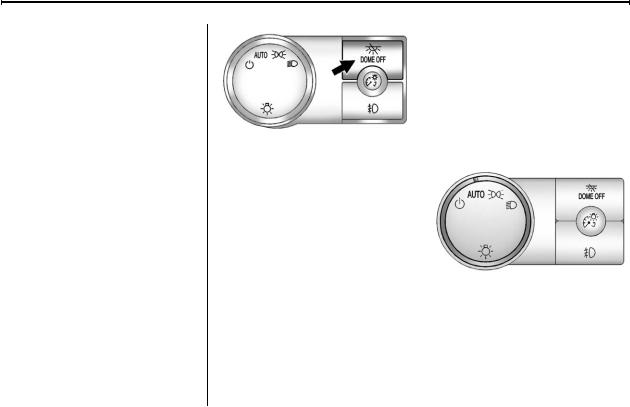
1-14 |
In Brief |
Press the bottom of the control to move the pedals closer to your body. Press the top of the control to move the pedals away.
See Adjustable Throttle and Brake Pedal on page 9 22.
Interior Lighting
Dome Lamps
The dome lamps are located in the overhead console.
They come on when any door is opened and turn off after all the doors are closed.
Turn the instrument panel brightness knob located below the dome lamp override button,
clockwise to the farthest position to manually turn on the dome lamps. The dome lamps remain on until the knob is turned counterclockwise.
Dome Lamp Override
The dome lamp override button is located next to the exterior lamps control.
k : Press the button in and the dome lamps remain off when a door is opened. Press the button again to return it to the extended position so that the dome lamps come on when a door is opened.
Reading Lamps
For vehicles with reading lamps in the overhead console, press the button located next to the lamp to turn it on or off.
The vehicle may also have reading lamps in other locations. To turn the lamps on or off, press the button located next to the lamp.
For more information about interior lamps, see:
.Dome Lamps on page 6 7.
.Reading Lamps on page 6 7.
.Instrument Panel Illumination Control on page 6 7.
Exterior Lighting
The exterior lamps control is located on the instrument panel to the left of the steering wheel.
P: Turns off the automatic headlamps and Daytime Running Lamps (DRL). Turn the headlamp
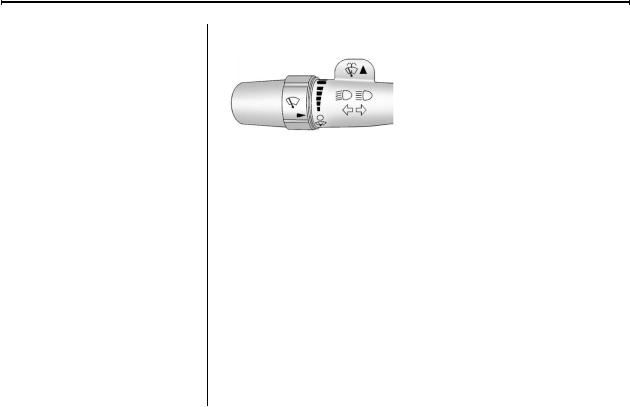
In Brief |
1-15 |
control to the off position again to turn the automatic headlamps or DRL back on.
For vehicles first sold in Canada, the off position will only work when the vehicle is shifted into P (Park).
AUTO : Automatically turns on the headlamps, parking lamps, instrument panel lights, license plate lamps, and taillamps.
;: Turns on the parking lamps, instrument panel lights, license plate lamps, and taillamps.
2: Turns on the headlamps, parking lamps, instrument panel lights, license plate lamps, and taillamps.
For more information, see:
.Exterior Lamp Controls on page 6 1.
.Daytime Running Lamps (DRL) on page 6 3.
.Fog Lamps on page 6 6.
Windshield Wiper/Washer
The front wiper control is located on the turn and lane change lever.
The windshield wipers are controlled by turning the band with z on it.
8: For a single wipe, turn to 8, then release. For several wipes,
hold the band on 8longer.
9: Turns the windshield wipers off.
6 : Turn the band up for more frequent wipes or down for less frequent wipes.
6
? : Fast wipes.
L: Push the paddle at the top of the lever to spray washer fluid on the windshield.
See Windshield Wiper/Washer on page 5 5.
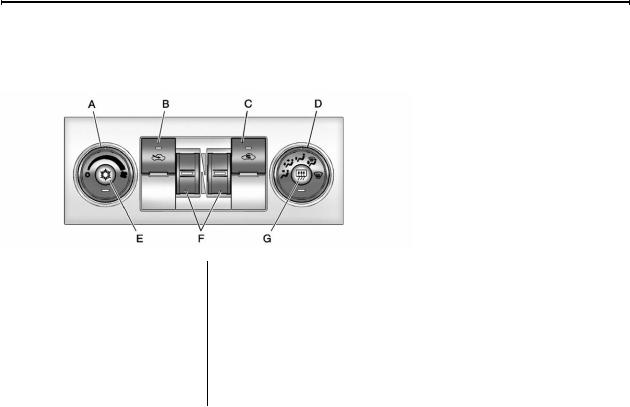
1-16 |
In Brief |
Climate Controls
The heating, cooling, defrost, defog and ventilation of the vehicle can be controlled with these systems.
A. |
Fan Control |
E. |
Air Conditioning |
B. |
Outside Air |
F. |
Driver and Passenger |
C. |
Air Recirculation |
|
Temperature Controls |
|
|
||
D. Air Delivery Mode Control |
G. |
Rear Window Defogger |
|
|
|
||
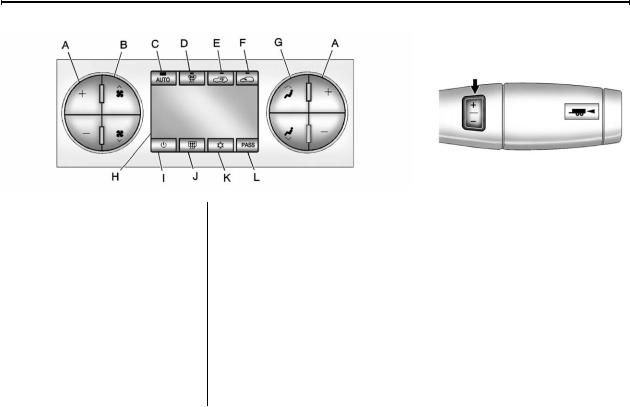
In Brief |
1-17 |
A.Driver and Passenger Temperature Controls
B.Fan Control
C.AUTO
D.Defrost
E.Air Recirculation
F.Outside Air
G.Air Delivery Mode Control
H.Display
I.Power Button
J.Rear Window Defogger
K.Air Conditioning
L.PASS
See Climate Control Systems on page 8 1 and Dual Automatic Climate Control System on page 8 4.
Transmission
Range Selection Mode
If available, the Range Selection Mode switch is located on the shift lever.
To use the Range Selection feature:
1.Move the column shift lever to the M (Manual) position. The current range will appear next to the M. This is the highest attainable range with all lower gears accessible. As an example, when 5 (Fifth) gear is selected, 1 (First) through 5 (Fifth) gears are available.

1-18 |
In Brief |
2.Press the plus/minus buttons, located on the steering column shift lever, to select the desired range of gears for current driving conditions. See Manual Mode on page 9 35.
While using Range Selection Mode, cruise control and the Tow/Haul mode can be used.
Grade Braking is not available when Range Selection Mode is active. See Tow/Haul Mode on page 9 36.
Four-Wheel Drive
If the vehicle has Four-Wheel Drive, you can send the engine's driving power to all four wheels for extra traction.
Automatic Transfer Case
Two Speed Transfer Case
Single Speed Transfer Case
The transfer case knob is located to the left of the instrument panel cluster. Use this knob to shift into and out of the different Four-Wheel Drive modes.
2 m : This setting is used for driving in most street and highway situations.
AUTO: This setting is ideal for use when road surface traction conditions are variable.

In Brief |
1-19 |
4 m : Use the Four-Wheel-Drive High position when extra traction is needed, such as on snowy or icy roads or in most off-road situations.
4 n : Vehicles with a two speed transfer case have a Four-Wheel-Drive Low position. This setting sends maximum power to all four wheels. You might choose Four-Wheel-Drive Low if you are driving off-road in deep sand, deep mud, deep snow, and while climbing or descending steep hills.
N (Neutral): Vehicles with a two speed transfer case have a
N (Neutral) position. Shift the transfer case to N (Neutral) only when towing the vehicle. See
Recreational Vehicle Towing on page 10 91 or Towing the Vehicle on page 10 91.
See Four-Wheel Drive (Two Speed Automatic Transfer Case) on
page 9 37 or Four-Wheel Drive (Single Speed Automatic Transfer Case) on page 9 42.
Vehicle Features
Radio(s)
Radio with USB, CD, and DVD (MP3)
O: Press to turn the system on and off. Turn to increase or decrease the volume.
BAND: Press to choose between FM, AM, or XM™, if equipped.
f : Select radio stations.

1-20 |
In Brief |
© SEEK or ¨ SEEK: Seek or scan stations.
4 : Press to switch the display between the radio station frequency and the time. While the ignition is off, press this button to display the time. Press to display additional text information related to the current FM-RDS or XM station; or CD, MP3, or WMA song. If information is available during XM, CD, MP3,
or WMA playback, the song title information displays on the top line of the display and artist information displays on the bottom line. When information is not available, “NO INFO” displays.
For more information about these and other radio features, see
Operation on page 7 3.
For vehicles with a Rear Seat Entertainment System (RSE) and Rear Seat Audio System (RSA), see
Rear Seat Entertainment (RSE) System on page 7 35 and Rear Seat Audio (RSA) System on page 7 45 for more information.
Storing Radio Stations
A maximum of 36 stations can be stored as favorites using the six softkeys located below the radio station frequency tabs and by using the radio FAV button. Press FAV to go through up to six pages of favorites, each having six favorite stations available per page. Each page of favorites can contain any combination of AM, FM, or XM stations.
For more information, see “Storing Radio Stations” in AM-FM Radio on page 7 8.
Setting the Clock
To set the time and date:
1.Turn the ignition key to ACC/ ACCESSORY or ON/RUN, then press O, to turn the radio on.
2.Press H to display HR, MIN, MM, DD, and YYYY (hour, minute, month, day, and year).
3.Press the softkey located under any one of the labels to be changed.
4.To increase or decrease the time or date, turn f clockwise or counter clockwise.
For detailed instructions on setting the clock for the vehicle's specific audio system, see Clock on
page 5 8.
Satellite Radio
XM is a satellite radio service based in the 48 contiguous United States and 10 Canadian provinces.
XM satellite radio has a wide variety of programming and commercial-free music, coast to coast, and in digital-quality sound.
A fee is required to receive the XM service.
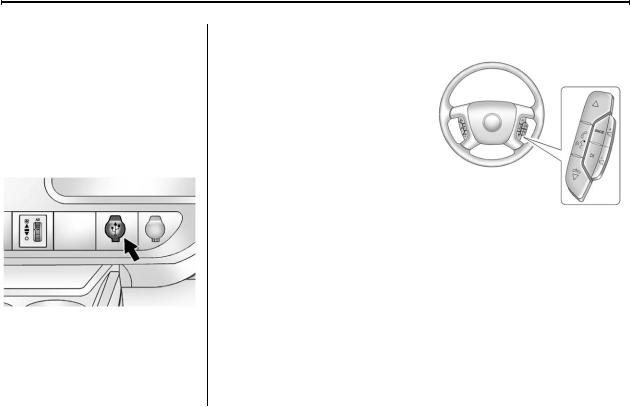
In Brief |
1-21 |
For more information, refer to:
.www.xmradio.com or call 1-800-929-2100 (U.S.)
.www.xmradio.ca or call 1-877-438-9677 (Canada)
See Satellite Radio on page 7 9.
Portable Audio Devices
This vehicle has an auxiliary input, located on the audio faceplate, and a USB port located in the center
console. External devices such as iPod®, laptop computers, MP3 players, CD changers, USB storage device, etc. can be
connected to the auxiliary port using a 3.5 mm (1/8 in) input jack or the USB port depending on the audio system.
See Auxiliary Devices on page 7 30 for further information.
Bluetooth®
For vehicles with a Bluetooth system, it allows users with a Bluetooth enabled cell phone to make and receive hands-free calls using the vehicle’s audio system and controls.
The Bluetooth enabled cell phone must be paired with the Bluetooth system before it can be used in the vehicle. Not all phones will support all functions. For more information, visit www.gm.com/bluetooth.
For more information, see Bluetooth on page 7 47.
Steering Wheel Controls
If available, some audio controls can be adjusted at the steering wheel.
w : Press to go to the next favorite radio station, track on a CD,
or folder on an iPod® or USB device.
c / x : Press to go to the previous favorite radio station, track on a CD, or folder on an iPod® or USB device. Press to reject an incoming call, or to end a call.

1-22 |
In Brief |
b / g : Press to silence the vehicle speakers only. Press again to turn the sound on. Press and hold longer than two seconds to interact with OnStar® or Bluetooth systems,
if equipped.
+ e : Press to increase volume.
− e : Press to decrease volume.
SRCE: Press to switch between the radio and CD, and for equipped vehicles, the DVD, front auxiliary, and rear auxiliary.
¨ : Press to seek the next radio station, the next track or chapter while sourced to the CD or DVD slot, or to select tracks and folders on an iPod or USB device.
For more information, see Steering Wheel Controls on page 5 3.
Cruise Control
T : Press to turn the system on or off. The indicator light is on when cruise control is on and turns off when cruise control is off.
+ RES : Press briefly to make the vehicle resume to a previously set speed, or press and hold to accelerate.
SET − : Press to set the speed and activate cruise control or make the vehicle decelerate.
[ : Press to disengage cruise control without erasing the set speed from memory.
See Cruise Control on page 9 51.
Navigation System
If the vehicle has a navigation system, there is a separate navigation system manual that includes information on the radio, audio players, and navigation system.
The navigation system provides detailed maps of most major freeways and roads. After a destination has been set, the system provides turn-by-turn instructions for reaching the destination. In addition, the system can help locate a variety of points of interest (POIs), such as banks, airports, restaurants, and more.
See the navigation system manual for more information.
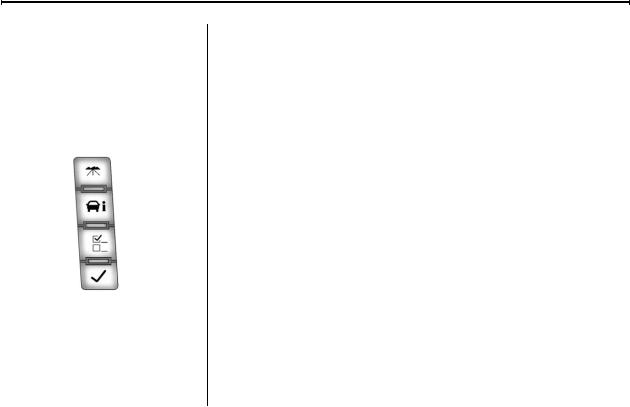
In Brief |
1-23 |
Driver Information
Center (DIC)
The DIC display is located at the bottom of the instrument panel cluster. It shows the status of many vehicle systems and enables
access to the personalization menu.
The DIC buttons are located on the instrument panel, next to the steering wheel.
Some vehicles do not have the buttons shown, however some of the menus can be viewed by using the trip odometer reset stem.
3 : Press to display the odometer, trip odometer, fuel range, average economy, fuel used, timer, instantaneous economy and Active Fuel Management™ indicator,
and transmission temperature. The compass and outside air temperature will also be shown in
the display. The temperature will be shown in °C or °F depending on the units selected.
T: Press to display the oil life, units, tire pressure readings for vehicles with the Tire Pressure Monitor System (TPMS), trailer brake gain and output information for vehicles with the Integrated Trailer Brake Control (ITBC) system, engine hours, compass zone setting, and compass recalibration.
U : Press to customize the feature settings on your vehicle. See
Vehicle Personalization (With DIC Buttons) on page 5 45 for more information.
V : Press to set or reset certain functions and to turn off or acknowledge messages on the DIC.
For more information, see Driver Information Center (DIC) on page 5 26.
Vehicle Customization
Some vehicle features can be programmed by using the DIC buttons next to the steering wheel. These features include:
.Language
.Door Lock and Unlock Settings
.RKE Lock and Unlock Feedback
.Lighting
.Chime Volume
.Memory Features
See Vehicle Personalization (With DIC Buttons) on page 5 45.
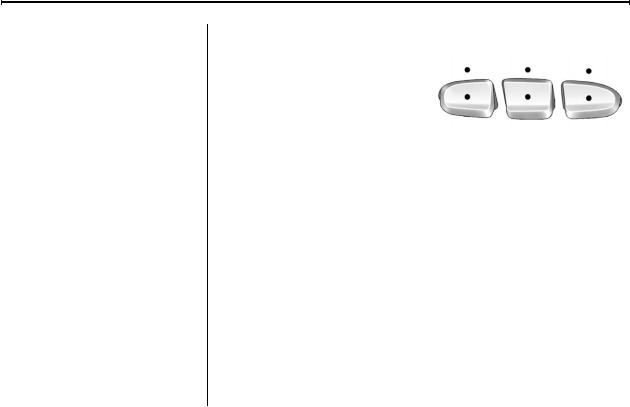
1-24 |
In Brief |
Rear Vision
Camera (RVC)
If available, the RVC displays a view of the area behind the vehicle when the vehicle is shifted into
R (Reverse). This is displayed on the inside rearview mirror or the navigation screen, if equipped.
To clean the camera lens, located in the bezel of the tailgate handle, rinse it with water and wipe it with a soft cloth.
For more information, see Rear Vision Camera (RVC) on page 9 56.
Ultrasonic Parking Assist
If available, Ultrasonic Rear Parking Assist (URPA) system uses sensors on the rear bumper to assist with parking and avoiding objects while in R (Reverse). It operates at speeds less than 8 km/h (5 mph). URPA uses audible beeps to provide distance and system information.
Keep the sensors on the vehicle's rear bumper clean to ensure proper operation.
See Ultrasonic Parking Assist on page 9 54 for more information.
Power Outlets
Accessory power outlets can be used to plug in electrical equipment, such as a cell phone or MP3 player.
The vehicle may have two accessory power outlets located on the instrument panel and one inside the center floor console.
The vehicle may also have an outlet on the rear of the center floor console above the cupholder door.
The accessory power outlet is operational at all times.
See Power Outlets on page 5 9.
Universal Remote System
Vehicles with the Universal Remote System will have these buttons located in the headliner.
This system provides a way to replace up to three remote control transmitters used to activate devices such as garage door openers, security systems, and home automation devices.
Read the instructions completely before attempting to program the transmitter. Because of the steps involved, it may be helpful to have another person assist with programming the transmitter.
See Universal Remote System on page 5 53.
